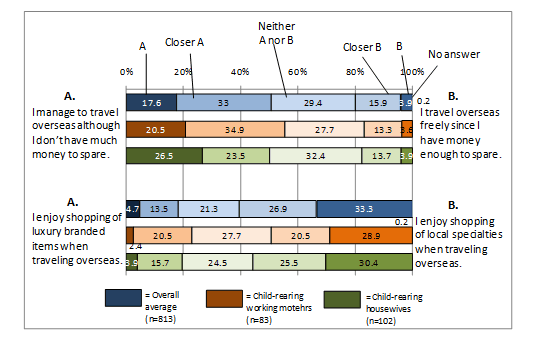Trends of Overseas Travel with Children (Part2) – Shopping behavior of female overseas travelers with children
Raising children requires households to bear great expense. This report covers the consumption behavior of women who enjoy overseas travel on a limited budget.

Hiromi Nakajima Columnist
Having a baby entails more monthly expense to households. As children grow, families should bear more expense for education, which makes them tighten their belt. Furthermore, in those households, quite a few mothers are unemployed since they are devoted largely to child rearing. Under these circumstances, mothers can hardly travel overseas partly because their children are small, but mainly because they cannot afford travel expenses.
Now, let’s look at whether mothers who travel abroad last year have money enough to spare or not. According to a survey on overseas travel conducted by JTM in 2008, the result of questionnaires (Chart 1) shows that traveling overseas doesn’t necessarily mean they are well off. Instead, they could travel abroad by managing the family budget resourcefully. The answers from Child-rearing housewives clearly indicate this tendency. As for shopping, they tend to be brand conscious. According to the breakdown of travel expenses, (Chart 2), there is little difference in the amount spent on shopping between women involved in child-rearing and total female respondents under the age of 50. Child-rearing housewives, spent 7,000 yen larger amount for shopping than the average female travelers.
Shopping is a common way for women to relieve their stresses. Mothers involved in child-rearing are usually busy with caring for kids and housework. Even on weekends, they have to be with their children. So, they can neither have a moment to call their own nor enjoy shopping for them. Working mothers don’t have to look after their children while they are working. But at home, they are as busy as beavers with taking kids to and from nursery, homemaking and caring for children. Mothers, who are not working, stay home with their kids day and night, keeping aloof from society. They must be under great stress. In order to ease such a strain, they appear to travel overseas aiming at escape from the trammels of everyday life, or to purchase branded goods for themselves. What matters a lot to women is that shopping is not for daily life and done just for their own.
Some women say, “I deserve to enjoy overseas travel as a treat which I give to myself once a year. I try to control living expenses and save some money for an overseas trip once a year”. Others utter, “I hope to relax in Hawaii. While my husband is looking after kids around the swimming pool, I would go shopping all by myself. I want to buy luxury branded goods just like I used to”. These are some of the voices of women who travel abroad with their children.
It also implies that mothers who have given up traveling overseas only because they have children may resume going abroad if an opportunity offers. That is because they belong to the group of women in their 30s and 40s who are basically fond of overseas travel. There is a possibility that they restart to enjoy overseas travel as a way to relieve stress or a treat for themselves.
(The report continues further to study the services available to overseas travelers with children.)
Chart 1: Preference of Overseas Travelers

Chart 2: Average per capita expense of overseas travel (Family vacations only)

Source: Japan Tourism Marketing Co. “Factual Survey of the Overseas Travel Situation” (2008)
Remarks: Female respondents aged under 50 only
*Child-rearing working mothers: Employed women whose youngest child is in the middle school age and under
**Child-rearing housewives: Unemployed mothers whose youngest child is in the middle school age and under
